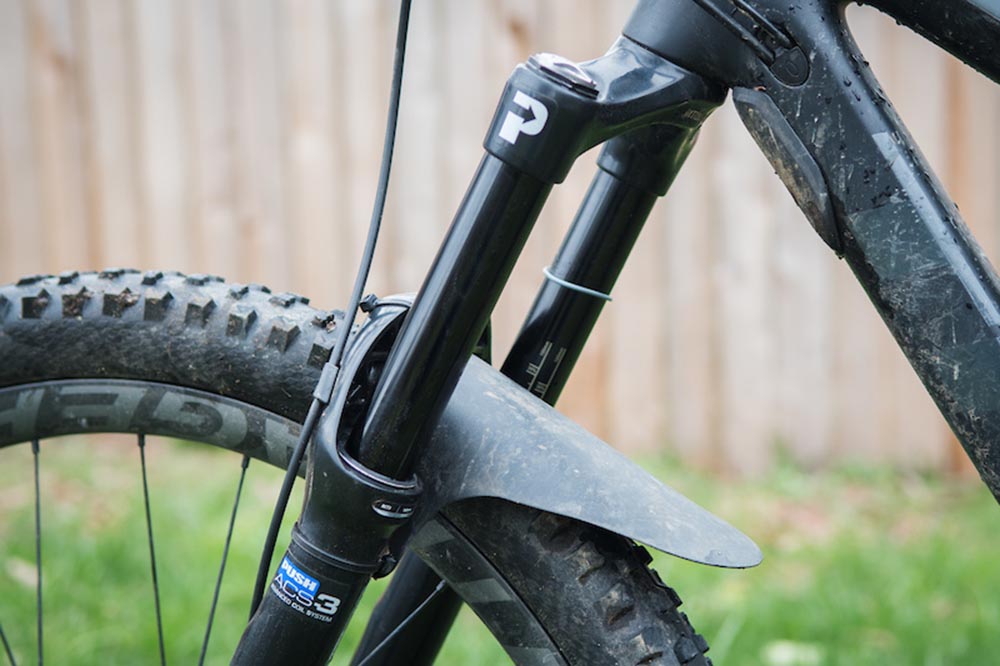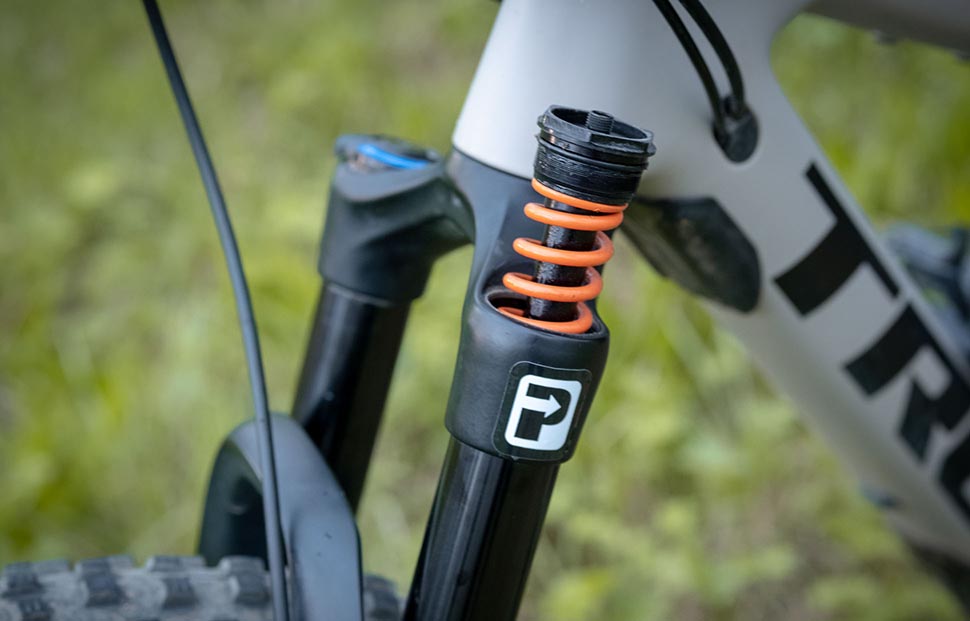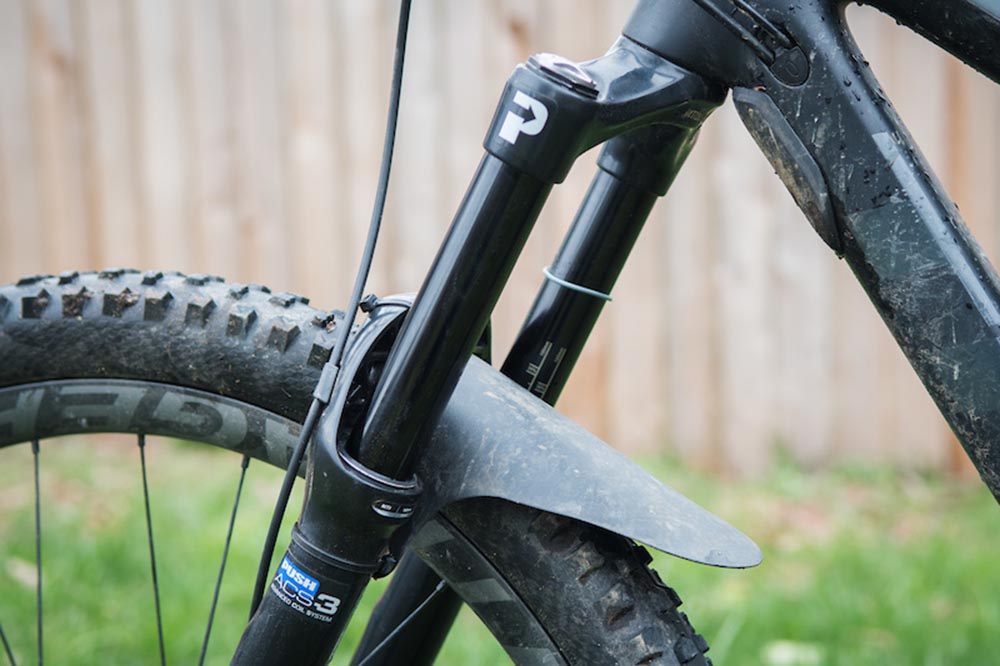Coil Forks: Pros and Cons

Coil forks have started to make a comeback thanks to some performance improvements. Especially suitable for enduro and trail riding. This guide outlines the pros and cons of using coil forks versus air forks for mountain biking. We’ll cover handling, adjustability, maintenance requirements, sensitivity, weight, comfort, price, versatility, ride feel, and more.
What is a coil fork?
Coil forks use metal coil springs to provide resistance. The coils are made of steel or titanium. The coil fork has a linear spring rate. This means that the force required to compress the spring increases over the entire range of travel of the fork.
For example, if it takes 500N to compress the spring 50mm, it takes 1000N to compress the fork 100mm. The total distance the fork can compress is called the stroke. This is usually between 80-200mm, depending on the type of mountain bike.
To adjust the spring rate of the coil forks, you can swap out the coils for stiffer or softer options. You can set the fork sag by turning the dial on the top of the strut. This changes the preload on the spring by compressing or decompressing the spring. Increasing the preload compresses the spring, making the fork stiffer and reducing sag. Most coil forks also have a locking feature to prevent them from compressing.
Fork coils are identified by two numbers. The first number represents the force required to compress the fork a given distance. This is measured in pounds per inch or newtons per millimeter. For example, a 40 lb/in spring needs 40 lbs of force to compress the fork 1 inch. Coils are usually supplied in 5 lb increments. The second number represents the total travel of the coil. For off-road or off-road bikes, you may only need 100-120mm of travel. For downhill mountain bikes, you may need 180-200mm of travel.
The coil forks also have a damping system, just like the air forks. The coil and air fork’s damping systems work the same way. I’ll discuss damping in more depth later.
Coil Fork Advantages
1. More sensitive to small bumps
Coil forks have fewer seals. Existing seals can be looser as the shock does not need to be airtight. There is less friction in the system because there are fewer moving parts rubbing against each other. This means the coil fork has less stiction or stiction to handle. As a result, the separation force is low. In other words, the impact force required to initiate movement of the coil yoke is low. This allows for greater sensitivity to small collisions.
The coil forks soak up bumps that the air forks won’t even react to. The coil fork also reacts slightly faster when you hit a bump. Additionally, the sensitivity of the coil forks allows the dampers to work better. All of this gives the bike a smoother, more supple ride feel.
2. Coil forks require less frequent maintenance
Most riders must perform maintenance on their coil forks every 6-9 months. By comparison, for the average rider, air forks require maintenance every 3-6 months.
The main reason coil forks require less maintenance is that they have fewer seals. This makes the fork less sensitive to dirt, dust, and other contaminants that cause wear or damage. Since there are fewer seals, the coil fork also generates less friction when operating. This means that the coil forks don’t heat up as much. Therefore, these components do not degrade as quickly. Oil and seals can last longer. For these reasons, coil forks have longer maintenance intervals than air forks.
Fewer parts need to be cleaned or replaced when the fork needs to be serviced. To keep your coilover fork running smoothly and efficiently, most manufacturers recommend that you rebuild your fork every 100-200 riding hours. For most riders, this is every 12-18 months. This includes replacing all seals and oil and checking dampers and springs. You should have the rebuild done by a professional.
You should service the lower fork every 50-100 riding hours or between full rebuilds. This involves replacing foam rings, dust seals and topping up with oil. After each ride, you should wipe down the fork to keep it clean. It is especially important to keep the struts clean to avoid getting scratched.
3. Coil forks provide better traction
Coil forks are more sensitive to small bumps because they create less friction when operating. This allows the front wheel to more consistently track the contours of the ground as you ride. The front tire stays on the ground instead of bouncing.
The coil’s linear spring rate curve also makes the suspension feel a little more responsive. This is especially true when riding rough trails or rocky sections. These features help improve traction.
Improved traction allows you to turn harder without worrying about the wheels being washed out. You can also brake harder. The extra traction makes the bike feel more stable and solid. This inspires confidence and makes you ride faster. Coil forks are great for trails with loose surfaces like gravel or sand and trails with lots of tight corners.
4. More comfortable ride
The coil fork picks up small bumps that the air fork might not react to. You’ll also feel less chatter and less vibration when riding on rough surfaces. This is thanks to excellent crash sensitivity. This makes for a smoother and more comfortable ride. Your hands and arms won’t tire as quickly because there’s less vibration.
The linear spring rate of the coil fork also makes the bike feel more grounded. After the hard hit, the fork travels in a more controlled fashion. This is possible because there is less friction in the system. The damping system could do better. As a result, the coil forks feel less springy. Those with joint pain or back pain will appreciate the smoother, more comfortable ride quality of the coil forks.
5. You can ride faster with coil forks
Most riders are slightly faster on coil forks than air forks. The main reason is the superior crash sensitivity. This allows the front wheels to better track the contours of the ground, improving traction. This, in turn, allows for better cornering and braking. With the coil forks, you can corner and brake harder without flushing the front wheel.
The coil forks also make for a smoother ride. When the bike is stable and not bouncing under you like a Mustang, you have more control over your bike. You can steer slightly more accurately with an air fork.
These are marginal benefits, but they can add up. For these reasons, many competitive riders prefer coil forks. By switching from air to coil forks, you can shave 1-2 seconds off your average downhill run. An exception might be trails with lots of falls and jumps. Linear spring rates mean that the coils sometimes don’t provide enough support. You may have to hit some obstacles more slowly or you may bottom out.
6. More suspension range available
The coil fork’s linear spring rate allows you to take advantage of the entire suspension range. This is possible because the force required to compress the suspension remains constant over the entire range. It didn’t go up. The suspension absorbs big bumps better when you have the full range at your disposal.

7. Better braking performance
The linear spring rate of the coil forks allows for better mid-stroke support. The bike doesn’t want to dive too much when you brake hard. This allows you to brake harder. You also don’t have to worry about going over the handlebars when braking hard.
As an added bonus, you can use less compression damping. By contrast, air forks can feel too soft at the beginning and midway of their travel, causing the bike to dive under heavy braking.
8. Coil forks are more durable, reliable and durable
Coil forks have fewer moving parts that can fail. For example, there are fewer internal seals and no air valve. This means fewer parts can be contaminated. There is no air chamber. You don’t have to worry about leaks. The coil always works.
Coil forks also handle oversights better than air forks. If you don’t do frequent maintenance, you can usually get rid of it with a coil fork. They can take a beating and not fail. If you plan to ride great distances, a coil fork may be a safer and more reliable option. It’s unlikely to get you into trouble.
9. Coil forks are cheaper
Coil forks were initially slightly more expensive than air forks. They generally cost less over their lifetime because they require less maintenance. For example, if you keep your bike for 10 years, you might only need to service your coil forks 20 times. During the same 10-year period, you may need to service your air fork 30 times. Longer maintenance intervals may save you $100 per year over the life of the fork.
A full fork service costs around $150. A basic service costs about $50. The less frequently you perform maintenance, the more money you will save. Of course, you never want to neglect maintenance, or you’ll end up spending more time replacing the entire fork if it wears out prematurely.
One extra expense you may have to add to your coil fork is buying a different coil. If you want to change the spring rate of the fork, you need to buy a new set. A set of coils typically costs $30-100, depending on the material. Titanium coils cost more than steel. If you are happy with the way the fork is set up, you will never have to worry about changing the coils. They are almost always there.
Coil Fork Disadvantages
1. The adjustability of the coil fork is poor
To change the spring rate of your coil fork, you will have to replace the coil with a stiffer or softer model. Coils are usually sold in increments of 5 or 10 pounds per inch. There may only be 3 or 4 different coil options compatible with your fork. Your ideal spring rate coil can be somewhere between the two sizes. You can’t dial in the exact spring rate you want like you can with an air fork.
If you buy a new mountain bike with a coil fork, you may need to replace the coil right away. Most mountain bikes are sold with coils that are ideal for moderate-weight riders (about 160-180 pounds). If you are a heavy or light rider, you may need to replace the coils to achieve the proper spring rate. You may want to take this into account when buying a new bike.
Also, you cannot adjust the progression of the coil fork. They operate linearly. You can fine-tune the sag by adjusting the preload. Most coil forks allow you to adjust the damping. Sometimes only rebound damping can be adjusted. Higher-end models also allow you to adjust compression damping.
2. Coil forks are harder to adjust
In order to change the spring rate of the coil fork, you have to replace the coil. This involves taking apart the fork. This is quite a job and requires some knowledge of tools and mechanics. That means you can’t easily adjust the spring rate for different trail conditions or rider weight.
If you’re riding on tough roads or want to install a bike bag, you’ll have to use your current setup or take the time to replace the coils. If you gain or lose weight, you will have to buy new coils and swap them out. You don’t want to adjust the spring rate before every ride. You can’t make adjustments on the trail side as easily as you can with an air fork. You can easily adjust the coil fork preload and sag by turning the dial.
3. The coil fork has no stage adjustment
Metal coil springs run linearly. In other words, the force required to compress the coil increases over the entire range of travel. No progress adjustment is required. Progressive coils can be made by using two separate springs of different stiffness. The stiffer spring will effectively increase the spring rate when the softer spring bottoms out. These types of progressive coils are available for motorcycles, but I am not aware of any commercially available progressive fork coil options for mountain bikes.
4. The coil fork has poor resistance to bottoming
Bottoming occurs when your coil is fully compressed. Coil forks bottom out easier because they have a linear spring rate. The force required to compress the suspension increases throughout the travel range. It didn’t go up. Therefore, the total force required to fully compress the coil fork is less than the total force required to fully compress the air fork. In other words, it’s easier to bottom out the coil forks on hard hits or landing from jumps or big drops. This assumes both forks are set to the same rider weight. You’ll know you’ve bottomed out when you hear a pop and your fork suspension stops moving.
Bottoming out is not the end of the world. Most forks have bumpers built into them to prevent damage on hard bottoming. This is a rubber ring that prevents metal-to-metal contact when the spring is fully compressed. If you bottom out too hard or more than once per ride, your fork coils may not be stiff enough for your weight and riding type. In this case you should replace your coils with stiffer models to increase the spring rate. Hard or frequent bottoming can wear out the bottoming protection and eventually damage the fork. A particularly hard bottoming could even damage your wheels or frame.

5. The coil fork is heavier
On average, coil forks are 300-500 grams (about 10-18 ounces) heavier than comparable air forks. A lightweight coil fork weighs approximately 2100 grams (4.6 lbs). A lightweight air fork weighs approximately 1600 grams (3.5 lbs).
Coil forks are heavier because they use heavy metal coils to provide resistance, while air forks use weightless air to provide resistance. The weight difference also depends on the coil spring rate. Generally, coils with higher spring rates are heavier because thicker gauge metal is required to make stiffer coils. This adds weight.
The heavier weight of the coil fork makes the steering feel a little slow and unresponsive. It’s also harder to pop the front wheel off the ground. The added weight also makes the bike harder to climb and accelerate. It takes more energy to move more mass. You can reduce the weight of the coil forks by installing lighter springs. For example, titanium coils are much lighter than steel. Of course, they are also more expensive.
6. The versatility of the coil fork is poor
Because they are difficult to adjust, you cannot easily optimize your coil forks for every ride. You also can’t easily adjust the fork for different types of mountain bikes. This makes bikes with coil forks less versatile.
For example, maybe you want to use the same bike for trail riding and bike packing. You may want softer coils for trail riding, while firmer coils can support the extra weight of your gear when the bike is packed. You have to buy different coil sets with different spring rates, take apart the forks and replace them to optimize the bike for different types of riding. Most riders don’t want to bother with this constantly. This is not practical.
So you can’t easily use the same bike for multiple rides. You definitely don’t want to go through this every time you ride. With an air fork, you can easily adjust the spring rate or schedule using the shock pump. You can even make adjustments on the go.
7. Flat riding characteristics
Coil forks tend to keep the bike on the ground. They offer a smooth and luxurious ride. For some riders, this can make the ride feel a little boring and flat. The bike doesn’t want to pop or jump. The coil fork may lack support when landing from a fall or jump. Some riders like the flat and stable ride characteristics. Others prefer the more snappy and springy ride characteristics of the air fork.
8. The coil fork makes some noise
The metal coil may hit the inner wall of the fork body during compression. When this happens, you will hear a clicking sound. If the spring doesn’t have enough preload, it will hit the bottom of the fork and make some noise. Worn seals can also cause some noise from the fork. If your coil fork is properly maintained and adjusted, it should run quietly.
9. Fewer forks and bike options
If you walk into a bike shop, you will find that very few bikes these days come with coil forks. If you buy a new coil fork to install on your existing bike, you will find that your options are limited. Most forks have air springs. This situation is slowly changing. Riders notice a smoother ride, agility and superior traction. Some people are switching back to coil forks.
If you are looking for a new way of commuting or want a healthier lifestyle, we are here to help you. Visit our website to learn more about electric bikes and electric scooter or please leave information to us.
 Shuangye ebike
Shuangye ebike
